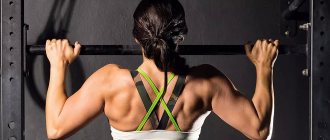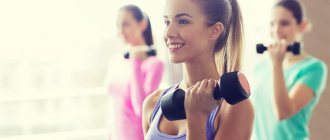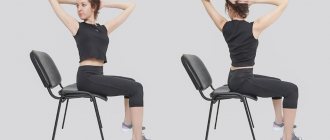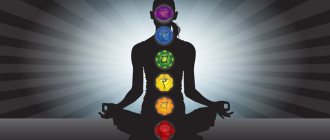A properly selected set of physical exercises for home is an excellent alternative to systematic trips to the gym. After all, everyone wants to look good and have a spectacular figure. However, not everyone manages to go to the gym regularly. A constant lack of time, financial difficulties or other obstacles become the main reasons why many give up sports, and in vain. If you properly develop a training regimen and purchase a few simple sports equipment, home exercises will prove to be very effective.
The benefits of gymnastics for adults
Individual or group gymnastics is not only a fashionable trend in fitness, but also an interesting way to spend time together for a group of friends or colleagues.
Gymnastic exercises:
- accelerate metabolism, stimulate the body’s immune system, as a result of which a person loses extra pounds, strengthens the immune system - less likely to suffer from colds and viral diseases;
- “unload” the brain and increase performance. Gymnastics classes for beginners are low-intensity, so they are recommended by doctors as a means of combating stress, chronic fatigue, and depression. Regular training increases the production of “joy hormones” - serotonin and dopamine, the concentration of which directly affects the feeling of fatigue;
- increase sexuality - due to the normalization of blood circulation, women and men experience an increase in libido;
- strengthen the cardiovascular system, normalize blood pressure, reduce the risk of blood stagnation and the appearance of varicose veins;
- stimulate the lymphatic drainage system, help the body cleanse itself of harmful accumulations and toxins;
- solve sleep problems.
The gymnastics club is a place for new meetings and acquaintances. By signing up for gymnastics, a person joins a community of people who are equally passionate about sports, for whom movement is life.
In order for gymnastics to be beneficial, you must practice under the supervision of a trainer, follow the technique of performing the exercises, and also do not neglect stretching before and after exercise.
General developmental gymnastics
General gymnastics is a common type of physical activity. There is no bet on results or records; all classes are aimed at developing a person’s physical capabilities, improving health, and increasing muscle tone. The training complex is based on basic fitness exercises that, when performed correctly, do not injure joints and tendons.
The general gymnastics section is especially useful for people with problems with the cardiovascular system and musculoskeletal system. It is recommended to use individual exercises from the training cycle as a set of morning exercises to awaken the body and get a boost of energy for the whole day.
General gymnastics also acts as preparatory measures for heavy loads: it warms up the muscles, accelerates the blood, develops ligaments, and improves joint mobility. More information about this type of physical activity can be found in the SOYUZ club, where group and individual classes in general developmental gymnastics are held.
Strength gymnastics
Strength gymnastics involves exercises with weights to create additional resistance to the muscles. Today, both men and women choose this type of fitness. Regular training allows you to build muscle mass, remove fat deposits, tighten and improve body contours.
Each lesson consists of three stages:
- warm-up, with cardio exercises to warm up muscles and joints, preparing the body for stress;
- strength exercises - for beginners, your own weight is often enough;
- stretching exercises.
You can do strength gymnastics at home, but at the first stage it is better to join a sports club to master basic exercises under the supervision of a trainer. He will monitor your body position, draw up a training program, and select a load in accordance with your level of physical fitness.
For those who are bored with lifting weights, we recommend paying attention to CrossFit. The SOYUZ club employs professionals in this area, so you can easily get detailed advice, see the strength training of champions and be able to decide whether strength gymnastics is right for you or not.
Gymnastics
It should be understood that rhythmic gymnastics for adults is one of the types of fitness training, and not a serious application for Olympic records. All exercises are performed in a limited amplitude and do not require super preparation from childhood.
When choosing a gym and trainer, be sure to attend 1-2 classes as an observer. You will appreciate the future mentor's working style, atmosphere, as well as the required level of physical fitness.
As a rule, women come to training who want to discover new capabilities of their body, improve flexibility and coordination of movements, and develop a sense of rhythm. Exercises with additional equipment (balls, ribbons, jump ropes, mace) add variety, help you gain a regal posture, strengthen muscles, and remove fat deposits.
Acrobatic gymnastics
In many ways it has something in common with artistic gymnastics - jumps, steps, and dance steps are also perfected here. People often sign up for training sessions with friends and colleagues - working together strengthens social connections and interpersonal trust, helps to loosen up and gain a sense of leverage.
Modern gymnastics is multifaceted: you can become seriously interested in acrobatics, train in a group, receive ranks and perform in competitions. Or you can simply study individual elements for yourself, surprise your loved ones with success and enjoy small victories.
By force of muscle contraction
Gymnastics helps develop three factors, which include strength, speed and endurance, the following classification defines their combination:
- strength training is necessary to improve and develop strength;
- when developing dynamics, speed-strength exercises are an excellent option;
- Constant repetition of endurance exercises will help develop muscles.
Depending on the type of exercise, a set of exercises can be repeated from fifteen minutes to several hours, so it is important to combine different options.
Where to start classes?
Modern people often do not have enough time to go to the gym, so a large number of people stop at home exercises. In order for gymnastics for beginners to be fruitful and become a habit, you need to remember a few recommendations:
- You need to develop the habit of waking up 15 minutes earlier than usual. This is necessary so that the lesson has a normal pace, because no one wants to reduce the usual time allotted for hygiene, eating and cosmetic procedures.
- As soon as a person wakes up from sleep, he should not jump out of bed. First you need to do a couple of breathing exercises and self-massage. All this will help you recover faster after sleep and cheer up.
- You need to choose exercises that will correspond to the degree of training and the general condition of the body. Perhaps a person suffers from some kind of disease, in this case, before starting classes, you need to consult with your doctor.
- The number of repetitions of exercises should be selected individually. The same applies to the rhythm of movements.
- The load should be increased gradually. If discomfort or shortness of breath appears, you need to stop doing the exercise or reduce the load.
- Gymnastics for beginners must include exercises in which the load is evenly distributed to all parts of the body so that all muscle groups are involved.
- When doing gymnastics, you need to monitor your breathing. It should be uniform and deep. This will allow the muscles to be fully saturated with oxygen.
- It is best to exercise in special comfortable clothing that does not restrict movement. It is better if the training suit is made of cotton fabric.
- If possible, it is preferable to do gymnastics in the fresh air. As a last resort, you can open the window.
- It is best to do gymnastics while listening to fast and rhythmic music. This will allow you to tune in to a positive mood.
- After training, it is recommended to take a shower.
- During the day, you should try to do at least a few exercises that will help relieve stress.
- Walking is a must every day. In this case, you should perform special breathing exercises.
- If a person has already started doing gymnastics for beginners, then one should not stop training under any circumstances. The only exception is a very high temperature or a serious illness.
Gymnastics directions
There are several types of gymnastics. Each option provides the opportunity to achieve the goal as quickly and efficiently as possible.
Therefore, you should first familiarize yourself with the available areas and choose the most suitable one for yourself in order to get not only the desired result, but also pleasure from the training process itself.
General rules
As far as we know, any sport is useful not only for men, but also for women. This is especially true when doing athletic gymnastics. Mostly women engage in this sport in order to lose extra pounds and make their figure more attractive by pumping up their leg muscles and removing their belly, as well as making their buttocks more elastic. Unfortunately, the rules are the same and they apply to both men and women:
- Include running in place and jumping rope into the complex. When performed for a short duration, these exercises are highly effective in the fight against excess weight.
- Choose exercises aimed at correcting problem areas. This individual approach to training increases their effectiveness.
- Drink water during training; an imbalance in water balance will not only reduce the effectiveness of your workouts, but will also lead to health problems.
- Eat no earlier than 2 hours after finishing your workout. Eating earlier will reduce all efforts to zero. Before classes, but no later than an hour before them, eat foods high in protein - legumes or soy products.
On a note! Regular exercise reduces physical stress on the body as a whole. By increasing calorie consumption, weight loss occurs much faster.
Gymnastics: features of the discipline and its definition
Gymnastics can be called a special culture of developing physical skills, building muscles and strength, combined with endurance and stability.
The set of classes includes various loads that help stretch muscles and increase their mass, making it possible to develop a certain muscular strength.A unique physical discipline is carried out using stationary or portable simulators and devices. Depending on your goals, you can choose running and squats, jumping and throwing, lifting and hitting, which together help strengthen health and immunity.
Sample training program for beginners
Such exercises are performed with additional weight, which can be dumbbells or any other suitable load.
Sample exercises:
- Feet are placed shoulder-width apart, and arms are raised above your head, holding the load. The next movements are bending down so that the hands with the load pass between the legs. This exercise is repeated up to 15 times.
- Position - standing straight, holding your hands with a load at chest level. The arms are straightened, after which the load is lifted above the head. You need to keep your back straight. The movements are repeated up to 15 times.
- The legs are placed at a level wider than the shoulders. The load and arms are raised above the head, after which bends are made, now in one direction, then in the other. The arms do not bend. The number of such movements is up to 12 times in one direction and the other.
- Position: lying on your back. The legs can be secured by sliding them under a sofa or under a closet. The arms are extended above the head and the torso is raised. The number of such movements is up to 12 times.
- Feet are together, and arms with a load are lowered in front of you. Raising your arms up and spreading your legs to the sides, you perform a low jump. The jumps are repeated about 15 times.
Gymnastics at home: exercises for weight loss
As you know, in order for your body to start losing weight, you must burn more calories than you consume. Diets alone cannot solve this issue, so you need to add gymnastics to your daily activity. It should be taken into account that exercises in such gymnastics must be energy-intensive, i.e. you must make efforts “to the maximum”, to do through “I can’t”. It is these activities that will force your body to work in an enhanced mode, during which calories will be lost.
What should be effective gymnastics at home, exercises for which are designed to literally “burn” calories? These workouts should include all muscle groups. A set of exercises, for example, may be as follows.
- “Scissors” - this exercise perfectly works the abdominal muscles. To perform it, you need to lie on the floor, rest your hands on it, and begin to slowly raise your legs to an angle of 90 degrees, while crossing them alternately. In the same way, you need to slowly lower your legs down. This counts as one time. Perform three sets of 10-15 reps.
- “The book” is an exercise for the press that involves all the muscles of a given part of the body. Sit on the floor with your hands shoulder-width apart behind you and tilt your head back slightly. Then simultaneously pull your legs, bent at the knees, and your body towards each other, as if “folding”, like a book.
Squat plie. Place your feet as wide as possible while still maintaining stability. Spread your socks slightly to the sides. Then, from this position, perform a squat, moving your pelvis back, as if you were sitting on a chair. Make sure that your knees bend strictly towards your toes. For greater efficiency, you can take weights into your hands, for example, several heavy books.
- Lunges in place - take a wide step forward with your right foot, while your left remains motionless. In this position, squat down completely, bending your “dropped out” leg at the knees. Please note that the knee of the right leg should not go beyond the toe, and the knee of the left should not touch the floor. Do 10 of these squats, switch legs. For greater efficiency, you can take small dumbbells in your hands.
- Jumping jumps from a seated position: To do this, place your feet shoulder-width apart and perform a squat. This position will be the starting position. You need to jump out of it sharply, while simultaneously stretching your arms in the same direction. Then return to the starting position and immediately jump out of it, i.e. without stopping or pausing.
- Reverse grip push-ups: sit on the edge of a chair or sofa, then lean your hands on the furniture from behind, stretch your legs in front of you (you can bend your knees). Begin to push up from the edge, as if “sagging” down, while your pelvis and back should be on the same line. Imagine that you want to sit on the floor from this position.
All exercises are performed in 3-4 approaches, each with 10-15 repetitions.
By muscle mass involvement
Depending on the involvement in the set of exercises being performed, three groups of exercises are distinguished, from which an effective set of training can be created:
- local, when they are performed, no more than one third of the muscle mass is involved (exercises with a gymnastic stick or
- shooting); regional, up to 1/2 of the body weight is involved in their implementation (exercises for the muscles of the trunk, upper or lower extremities);
- global, to perform them it is necessary to activate almost the entire body (various types of running and cycling, rowing).
By choosing such activities, you can systematically develop and strengthen muscle mass, using the internal reserves of the body and developing yourself.
Features of classes at home
It is necessary to find the optimal rise time. You must have time to get everything done and still fit exercise into your schedule. The duration of classes for beginners is 10-15 minutes, and for those who have already more or less adapted to the stress - half an hour. After finishing charging, it is recommended to take a contrast shower for 10 minutes.
It is better to do all exercises on an empty stomach, having breakfast after exercise. You can also drink a glass of water after waking up - this will help start the gastrointestinal tract and help thin the blood.
Each exercise consists of three stages: warm-up, a set of basic exercises, and a final complex. It is necessary to distribute the load evenly. It is recommended to perform the exercises in order: from simple to complex. If you feel unwell, stop exercising. You shouldn’t torture yourself and practice through pain and discomfort.
Warm-up
Before charging, you need to do a short warm-up. Perform all exercises smoothly, without sudden movements.
Rotation of the head and neck
Smoothly tilt your head alternately to the left and right, then tilt forward so that your chin touches your chest.
The next exercise is rotational movements of the head clockwise and counterclockwise.
The last thing is turning the head to the right and left.
Warm-up, stage 1
Warm up your arms
Raise your arms to chest level and clasp your palms. Rotate your wrist joints, then your elbow joints. Stretch your shoulder joints by moving your arms outstretched or bent at the elbows in a circle, forward and backward.
Warm up your arms
Warm up your arms
Warm up your arms
Back and body
Hands on the belt, perform circular movements with the hip joint clockwise and counterclockwise.
Hip rotation
The next thing is to bend towards your left and right legs, straightening your back.
Legs
Raise your leg in front of you, bend your knee slightly and begin to rotate your ankle. If you have difficulty maintaining your balance, find support or rest your hand on a wall.
Finish your warm-up by walking in place. Let's move on to charging.
Exercises without objects
The most convenient and affordable training option is to perform exercises without additional sports equipment. Freedom of action gives you the opportunity to be active outside the gym or fitness club, at home or in the fresh air. In this case, the load is your own weight, frequency and sharpness of movements.
Below are several universal exercises that can be included in your gymnastics complex:
Starting position: standing, feet shoulder-width apart, shoulder blades pulled together, head raised, and eyes looking forward. We alternately raise our arms up through the sides, forward, do “scissors” and “wheel”, doing at least two repetitions for each of the listed movements.
By type of muscle strength contribution
The simple classification of gymnastic exercises depending on the contribution of muscle strength deserves special attention. Athletic activities require activation of internal forces, good muscle stretching and the ability to withstand increased loads in combination with developed motor qualities.
The second category includes technical exercises that are performed at home or in specially equipped gyms. To carry them out, the usual physical processes, gravitational force and engine thrust are used; this can be horse riding or parachuting.
A set of exercises for gaining weight - basic exercises and recommendations for selecting weights for exercisesWe perform squats with dumbbells - a description of the technique of performing the exercise. Subtleties and secrets of squats for girls (125 photos)
The best dumbbell press - advice from professionals and basic variations of the basic exercise (75 photos)
All types of gymnastic exercises have a general division into classes, which are responsible for the development of certain skills, abilities and characteristics.
The content and energy value of individual exercises is a determining factor in their selection and inclusion in independent exercises.
Experienced experts recommend that you consult with a trainer before compiling a set of exercises. This will help you navigate the correct way to perform the exercises and avoid injuries or sprains associated with strength and dynamic exercises.
Universal training
The general complex of kinesitherapy is suitable for every patient, regardless of age and health status. To select exercise therapy for a specific disease, you should consult a doctor.
Daily training (lasts 15-30 minutes).
Warm up in a standing position: stretching with raising your hands clenched into fists; rotation and tilting of the head in different directions.
1st block of exercises, do lying on your back:
- Pull your arm up, lifting your shoulder blade off the floor as much as possible – 8 times.
- “Frog”: bent legs on the feet; spread your knees to the sides, fixing your feet – 7-9 times.
- Half-bridge: hands on forearms, bent legs on feet; lift your body up, straightening one leg 5-6 times.
- Hands behind your head, legs bent. Raise the top of the body 10-12 times.
- To complicate the exercise: as you inhale, lift your body and tilt your bent legs to the side; as you exhale, lower your body and raise your outstretched legs. Repeat in the other direction, 7-9 times.
- Hands at your sides. Simultaneously turn the head and legs bent at the knees in different directions, 15-20 times.
- “Birch” against the wall: press your buttocks and feet against the wall, push off, straightening your lower back, 5-7 times.
- Pull straight arms and legs perpendicularly upward, repeat 6 times.
2nd block of exercises:
- Lie on your side, pull your straightened leg forward and backward 8-10 times.
- Lying on your side, describe a circle with your straight leg 8-10 times.
- Lying on your side with support on your elbow, pull your lower leg, bent at the knee, towards your chest 4-6 times on each side.
- Do push-ups from the floor with crossed legs, hands inward, back straight, 5-10 times.
- “Cat”: arch and bend your back while inhaling and exhaling 5-10 times.
- Lying on your stomach, bend upward while lifting your body and head 6-8 times.
- Sit on your heels, hands behind your head, head and chin forward. Turns in different directions, back straight, 10 times.
- Sitting on your heels, straighten up, spread your arms to the sides and rotate your shoulders back and forth 6-12 times.
- Standing on your knees, head down, chin pressed to your chest. Turn to the sides 7-10 times.
- After completing the complex for beginners, a relaxing cool-down is carried out (lying on your back, relax, watching your breathing).
Health-improving acrobatics
When the proposed exercises strengthen the main muscle groups, gymnasts begin complex acrobatic positions and tricks. Many people dream of learning how to make a wheel. Making a wheel is not so difficult if the muscle tone is normal and there are no diseases accompanied by dizziness.
Kinesitherapy - gymnastics at home - is useful for losing weight and strengthens the skill of maintaining balance in different body positions. First you need to master a handstand against a wall. It's easy to do:
- Stand next to the wall, facing it;
- Bend over and place your hands on the floor;
- Shift your weight to your hands, lift one leg off the floor;
- Place your straight leg against the wall and pull up your other leg;
- Keep your balance by resting your heels on the wall.
For those who are no strangers to home kinesitherapy, after 3-6 months, balance exercises turn out well. It's easy to do a cartwheel from a handstand against a wall (with support at first) by slowly lowering one leg down the wall. The pelvis and second leg will automatically begin to move, the lower back will bend and spring, the arms will push the body off the floor.
Exercises against a wall with support are done until the body “remembers” the algorithm of the trick.
When it learns to balance easily, it’s time to try doing a half-turn handstand. You need to practice in a spacious room, lay mats on the floor.
The main condition for correctly performing the “wheel” exercise is to keep your arms and legs straight. Then the wheel will be smooth, in one plane. If you are afraid of not maintaining your balance, you need to train with a partner so that he can provide backup for the beginning gymnast. After a week of training, the wheel will turn out on its own.
Change your lifestyle
Those for whom kinesitherapy is primarily a means of losing weight should remember that home exercises alone are not enough. The following rules must be followed:
- Stick to proper nutrition;
- Do not eat an hour before training and 2 hours after it;
- Drink at least 1.5-2 liters of clean water per day;
- In addition to home exercises , include swimming and running 2-4 times a week;
- After a month of training, you should gradually increase the load: do more repetitions and combinations of exercises.
There are many sets of exercises for weight loss that are not related to kinesitherapy (therapeutic gymnastics). They are designed for young and healthy people who want to correct their figure. There are known exercises for losing weight in the abdomen, arms, legs, buttocks, and back - complex and varied.
But for those who are overweight and are not in good health, it is still better to engage in exercise therapy - and the weight will return to normal and your health will improve.
Recent beginners, after losing weight and strengthening all muscle groups, will be able to perform the wheel and other acrobatic exercises.
A set of gymnastic exercises: types and classification
Depending on your own capabilities, the degree of development of physical culture and your goals, different workouts are selected. A training regimen and a set of gymnastic exercises are necessary for physical improvement and hardening, development of body and spirit.
Modern classification classifies different activities into several groups, which may overlap with each other.
Doing reverse crunches correctly - technique, subtleties, secrets and rules for performing the exercise (105 photos)Doing wide squats: technique of performing the exercise and correct positioning of the legs. 120 photos and videos of the main types of squats
Exercises in the gym - tips for choosing the best set of exercises. Recommendations for beginners and tips on how to practice correctly (85 photos)
Dividing allows you to easily select effective and beneficial exercises to improve your body, develop strength and strengthen muscle mass.
Where does aerobics begin?
Like any other sport, aerobics must begin with a warm-up.
We bring to your attention exercises that will help prepare your body for a more complex load at home.
Stretch your neck muscles
We stand straight, feet shoulder-width apart. Now we begin to perform circular movements of the neck clockwise, then counterclockwise. Number of repetitions – 10 times.
Without changing the starting position, we tilt our head forward, then back. Now left and right. Number of repetitions – 10 times in each direction.
Stretch the muscles of the arms and shoulder girdle
We stand straight, lower our arms down and clench them into fists. Then we begin to swing each hand separately, the opposite one should remain down.
Without changing the starting position, we bend the arms at the elbow joint and place our palms on the chest. Now we move our elbows back, first in a bent position, then in an unbent position. The number of repetitions is at least 15 times.
We stand straight, lower our arms down and relax them. We make circular movements with the shoulder joint, first in one direction, then in the opposite direction.
Stretch your core muscles
We stand straight, spread our legs at shoulder level, and place our hands on our belts. We begin to make turns with the body, first in one direction, then in the other.
This must be done carefully, with a gradually increasing amplitude of movement and speed. Number of repetitions – at least 20 turns in each direction
Without changing the initial position, we bend to the right and left, and we also need to reach with our hand in the direction in which we are leaning, for example, we lean to the right and stretch with our left hand. Number of repetitions: at least 10 bends in each direction.
We put our legs together and try to reach our toes with our hands.
We begin to do this exercise carefully and slowly, then gradually increase the pace. Number of repetitions – at least 20 inclinations
We stand up straight (if you are practicing at home, you need to stand near a wall or cabinet so that if something happens you can hold on) and bend one leg at the knee joint. Now we grab the heel with our hand and pull it towards the buttocks. Then we change the leg and do the same thing. Number of repetitions: 10 times on each leg.
And finally, we stand on our toes, raise our arms up and stretch as high as possible. We lower ourselves to the starting position and rest. The number of repetitions is at least 10 times.











